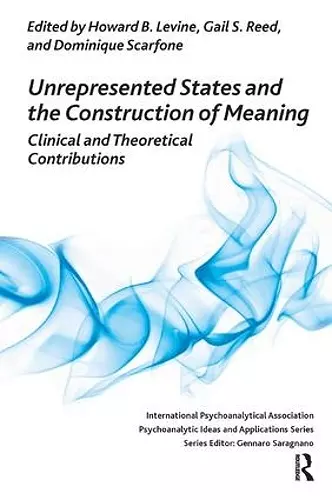Unrepresented States and the Construction of Meaning
Clinical and Theoretical Contributions
Howard B Levine editor Gail S Reed editor Dominique Scarfone editor
Format:Paperback
Publisher:Taylor & Francis Ltd
Published:1st Jan '13
Currently unavailable, and unfortunately no date known when it will be back
This paperback is available in another edition too:
- Hardback£125.00was £125.00(9780367101541)

In the last several decades, the analytic field has widened considerably in scope. The therapeutic task is now seen by an increasing number of analysts to require that patient and analyst work together to strengthen, or to create, psychic structure that was previously weak, missing, or functionally inoperative. This view, which may apply to all patients, but is especially relevant to the treatment of non-neurotic patients and states of mind, stands in stark contrast to the more traditional assumption that the therapeutic task involves the uncovering of the unconscious dimension of a present pathological compromise formation that holds a potentially healthy ego in thrall.The contrast which this book calls attention to is that which exists roughly between formulations of psychic structure and functioning that were once assumed to have been sufficiently well explained by the hypotheses of Freud's topographic theory and those that were not. The former are modeled on neurosis and dream interpretation, where conflicts between relatively well-defined (saturated) and psychically represented desires were assumed to operate under the aegis of the pleasure-unpleasure principle. The latter involve a different level of psychic functioning and registration, one that is more closely associated with pre-verbal, and/or massive psychic trauma, as well as with primitive mental states. It operates 'beyond the pleasure principle.' In complementary fashion, psychoanalytic theorizing has begun to shift from conceiving solely or predominantly of a universe of presences, forgotten, hidden or disguised, but there for the finding, to a negative universe of voids where creation of missing structure, often referred to by the Freudian metapsychological designation, representation, becomes of necessity part of the cure.However it is conceptualized psychoanalytically, representation is the culmination of a process through which impulse and content, and in favorable circumstances disguised versions of that part of the content that is unconscious, must all be linked. It is a term with historical roots in Freud's metapsychology, and its psychoanalytic usage refers back to that tradition and theoretical domain. It should not be confused with the way it or similar terms are used in other disciplines - e.g., child development or neuroscience - nor should references to its absence be misunderstood to necessarily imply the total absence of some kind of registration or inscription in 'the being,' i.e., the psyche or the soma, of the individual.
'This collection of essays brings together a group of eminent colleagues, who, in a series of original, rigorously argued and clinically illustrated articles, each in their own way, unavoidably ends up engaging with important aspects of the work of the late Andre Green. The choice made by the editors of working on unrepresented states and processes of representation strongly resonates with Green's ideas on the 'work of the negative.' As a result, this volume affirms the stakes so deeply explored by Green and illustrates their major practical consequences for the treatment of non-neurotic patients. The reader will find here much food for thought and reflection on the psychoanalytic theory of psychical functioning and its clinical implications.'- Jean Luc Donnet, Full member and Supervising Analyst of the Paris Psychoanalytic Society (SPP), former director of the Jean Favreau Center for psychoanalytic treatment, author of The Analyzing Situation'These essays convey and explore the spirit of the analyst at work, who, like the artist, must keep alive and assemble fragments of experience in order to create new meaning. Reading this book is therefore an aesthetic experience, one that provides fresh and pleasant impressions that may lead to a new, personal and mind-expanding integration of analytic theory. One comes away with a heightened, more vivid perception of psychoanalysis and its transformative possibilities.'- Antonino Ferro, Training and Supervising Analyst in the Italian Psychoanalytic Society, and author of Avoiding Emotions, Living Emotions and Mind Works: Technique and Creativity in Psychoanalysis'Reading this remarkable collection of thinking by an outstanding group of contributors is like taking part in a master class. The authors address areas for which previous analytic theory has not sufficed, areas that lie beyond the narrowly neurotic even as they are also often present in the underlying character structure of those who are neurotic. How are empty places, absences as well as presences, to be understood within the mind at work? What is the import of such voids, what their origins, and what their effects on the individual and the analyst? What is the place and the impact of the non-thinking part of the mind, and how does it work? How one can grapple with and make sense of what is not represented is the patient's problem in living, the clinician's problem in practice.This compendium has such consistently rare richness of both clinical reports and conceptual depth as to be an important and significant advance in analytic understanding. We are presented the ideas of earlier thinkers and we are presented original extensions of knowledge, moving our understanding of seeming voids, of psychic processes before thinking, to a new level. It casts valuable light on dark places in the mind.'- Warren S. Poland
ISBN: 9781780491318
Dimensions: unknown
Weight: unknown
304 pages